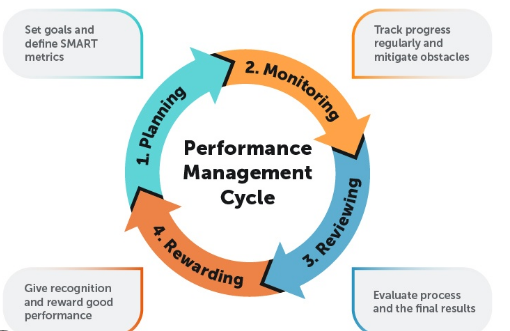HR procedures that are internally consistent and in line with organizational strategy must be put into place for high-performance management. It’s important to note that high-performance management is a continuous process where a performance management cycle is created by a number of various but integrated activities. It is not a procedure that ought to be carried out once a year and then stashed away in a filing cabinet.
What is high-performance management, its significance, nine performance management ideas for high-performing organizations, and other topics will be covered in this article.
Table of Contents
High-performance Management Origin Story
High-performance management hasn’t really existed for more than a century, as most people now understand it.
Taylorism and Principles of Scientific Management
F. is an engineer and management consultant. The relationship between employee potential and productivity was first studied by W. Taylor. In 1908, he developed scientific management principles that:
- Replaced “rule-of-thumb” work processes with those based on the scientific study of the tasks involved.
- instead of relying on them to learn on their own, carefully selected, developed, and trained every employee.
- created a cooperative environment with the staff to guarantee adherence to scientific procedures.
- divided tasks between managers and workers so that management could include these ideas in planning.
Early backers of Taylor’s performance management approach included Henry Ford. He broke down the production of vehicles into straightforward, routine tasks that any factory worker could master.
Taylor’s Performance Appraisal Model
Taylor subsequently unveiled a formal performance appraisal model in 1914, with a primary goal of enhancing worker productivity. This time, as opposed to organizational goals, he took into account the employee’s experience, punctuality, loyalty, and personality.
W.D. Scott
The Australian company WD Scott & Co. is where one of the first performance evaluations were ever formally documented. The management consulting firm first used an employee comparison scale in 1914, drawing inspiration from Taylor’s earlier research.
But until the 1930s, the more formal appraisal system was largely unknown outside the company. An annual performance evaluation based on Scott’s original system was introduced in organizations all over the world in the 1950s as better labor agreements and governmental procedures were established.
A Shift to Aspirational Performance Management
Performance evaluations up until the 1960s were primarily based on an employee’s personality traits, which had little to do with how productive they were at work.
Organizations began to emphasize goals and objectives in response, focusing on what workers may be able to accomplish in the future. This was the time when Peter Drucker’s 1954 system of “management by objectives” started to gain traction.
Further Refinement
Due to the subjective and prejudicial nature of appraisals in the 1970s, high-performance management was frequently linked to legal disputes. This sparked a shift toward performance rating scales and psychometrics, with additional improvements like 360-degree feedback being introduced in the 1980s and 1990s.
360-degree feedback was different in that it focused on employee motivation and engagement as a tool to increase performance. Teamwork, communication, conflict resolution, efficiency, and other ideas became the de facto metrics of choice.
Future of High-performance Management
Annual performance reviews are no longer used by many organizations today in favor of more frequent or continuous strategies. In the context of an encouraging and productive workplace culture, employee motivation and engagement are taken into account.
The impact of artificial intelligence on human resources will probably cause the emphasis to shift from quantity to quality going forward. In other words, the effectiveness of employee feedback will take precedence over how frequently an employee receives evaluations from their superior. Also more contextual, adaptable, and straightforward will be the feedback itself.
Understanding High-performance Management
Employees and managers alike frequently view performance management as the weakest aspect of human capital management.
Performance improvement is actually a rare outcome of performance management. It is a resource-intensive exercise, but this is still the case. Employees frequently report feeling deflated, unmotivated, and disengaged. The obvious lack of buy-in and the poor performance that follows irritate managers. It’s concerning to note that only 14% of organizations are happy with their current performance management system, according to research.
Because of the ambiguity surrounding what high-performance is, the situation is made more challenging. Michael Armstrong, the author, does offer a helpful definition though. He notes that “performance management is the continuous process of improving performance by setting individual and team goals which are aligned to the strategic goals of the organization, planning performance to achieve the goals, reviewing and assessing progress, and developing the knowledge, skills, and abilities of people.“
A performance management cycle is created by a number of distinct but complementary activities that make up high-performance management. It is not a procedure that ought to be carried out once a year and then stashed away in a filing cabinet.
The Importance of Performance Management
Every organization must have a talent management strategy. Three of the main problems that organizations face are:
- keeping employees engaged
- retaining talent
- developing leaders from within
Performance management effectively addresses these problems.
1. Keeping Employees Engaged
Any management team’s main goal is to keep their employees engaged. Goals would be set at the start of the year and then reviewed one year later to determine whether they had been achieved in a system of yearly appraisals. A near-certain engagement killer is this prolonged period without feedback or check-ins.
According to the Growth Divide Study, 81% of workers prefer at least quarterly check-ins with their manager, and 94% of workers would prefer their manager to provide them with feedback and opportunities for growth in real time.
Studies have shown that employees perform best when given feedback on a monthly or quarterly basis, with regular check-ins acting as a zone for problem-solving, goal adjustments as necessary, and reinvigorating goal focus. In fact, businesses with employee goal-review meetings quarterly or more frequently are almost 50% more likely to have financial performance that is above average.
When surveyed, employees had some negative feelings about a yearly appraisal system:
- 62% of employees feel that their performance review was incomplete
- 48% did not feel comfortable raising issues with their manager in between performance reviews
- 61% feel that the process is outdated
- 74% feel that they would be more effective with more frequent feedback
- 68% of executives don’t learn about employee concerns until the performance review
All of this results in numerous opportunities being lost to address issues and boost productivity and engagement among employees.
Absenteeism, turnover, shrinkage, patient safety incidents, safety incidents, and quality flaws are all reduced by at least 25%, and frequently more. Positive results are seen in customer satisfaction, productivity, and profitability.
This Gallup study, which covered a wide range of industries, demonstrates that employee engagement is important in every sector.
2. Retaining Talent
Employees are more likely to stay with a company if they meet with management frequently to talk about their performance, work out issues, and receive training.
Employees are more motivated to stay with the company and put in more effort if they perceive that their management team is working hard to advance their professional careers, assist them in achieving their goals, and reward performance consistently.
3. Developing Leaders from Within
The creation of leaders from within the organization is made possible by the constant growth and collaboration between managers and workers.
Recruiting expenses as well as onboarding and training fees for new hires can be very expensive. Being able to develop leaders from within the organization means that there is already evidence that this person fits the culture and that the money and resources invested in turning this person into an asset were not wasted.
Employees who see that their efforts will be rewarded with promotions and other advantages are motivated by this leadership style.
The need to consistently focus on company objectives and goals and to think about the best ways to achieve them is also brought on by performance management. Since goals are revisited frequently throughout the year, they are more likely to remain relevant in light of emerging technologies, shifting consumer preferences, and other factors.
The High-performance Management Cycle

Microsoft, General Electric, Adobe, and Deloitte are a few examples of businesses that have moved away from annual performance reviews and toward a more cyclical model.
This model incorporates the following elements:
- Plan. The creation of SMART objectives that are in line with organizational goals and a personal development plan are the main concerns in this situation. Job specifications for employees should be reviewed and updated as needed.
- Act. The employee should then perform their duties and accomplish the stated goals. Implementing a personal development plan is necessary.
- Track. Regularly monitoring progress is necessary, and obstacles should be addressed with coaching or feedback. To ensure that workers are given the time and resources they need to achieve their goals, some argue that feedback should be given once every three months.
- Review. The employee and HR manager should now evaluate their lessons learned and look back on their prior successes. Future plans and career objectives should be discussed and decided upon.
Basic Elements of High-performance Management
To encourage high-performance, HR managers should consider these building blocks:
- Goal setting – goals need to be set as early as practicable. The employee needs to understand why their goals matter in order to increase engagement and empowerment. How are their goals for the company and themselves being furthered?
- Transparent communication and collaboration – employees must be shown the respect of being kept in the loop at all times. Be sure to let them know if the business is having trouble. Additionally, they should be kept informed of pertinent information and given the chance to collaborate with their managers and coworkers. Transparency also entails that both parties never hesitate to bring up challenging or awkward subjects.
- Recognition – high-performance can be bolstered via incentivization. If nothing else, every employee needs to hear that their work is valued and appreciated. This could come in the form of a bonus or an award.
- Honest and regular feedback – the more frequent and concise the feedback, the higher the employee performance.
- Employee development – if an organization is succeeding at high-performance management, then it will naturally produce employees who want to further their own ambitions. Businesses should invest in their employees and not be afraid to lose key personnel to a rival.
Performance Management Ideas
1. Start With Clear Expectations.
Effective performance management begins with setting specific, outlined expectations. You cannot determine whether your employees are achieving or exceeding their objectives without setting clear expectations.
Be transparent and communicate the “why” behind your expectations. Employees benefit from knowing their significance in the overall scheme of things thanks to this.
2. Set, Track, and Check in on Goals.
Setting specific, compatible goals should be a joint effort between managers and staff. To assist employees in staying on task, specify key outcomes, and set deadlines.
Check-in on goal progress with ongoing communication to find out what is and is not working. Leaders can support and coach staff members to succeed by having this understanding in place.
Use goal-setting and tracking software to improve goal accountability and alignment. The proper platform elevates organizational objectives to keep everyone on the same page.
3. Create a Culture of Feedback.
Provide constructive criticism to employees so they can develop professionally. Use a platform designed to increase performance and trust to let employees see what they are doing well and where they are falling short.
An effective feedback tool will offer a platform for upward, downward, 180, 360, anonymous, and attributed feedback. Employees can then see what needs to be done to improve. As your staff members develop, they become more productive and produce results more reliably.
4. Recognize the Big and Small Things.
Employee contributions to the success of the team and the company deserve recognition, no matter how small. Even though it might just seem like a nice-to-have, this is crucial for boosting morale and motivation. When workers receive praise for their efforts, they are more likely to act in the same way again.
Use a recognition platform that informs the entire organization of your employees’ accomplishments. Highlighting their importance to the company and making them feel more valued, helps to maximize employee performance.
5. Coach through a Variety of One-on-one Meetings.
For managers and employees to stay on track, one-on-one meetings should be held at least once a month. Pay close attention to what is working well right now and what is preventing engagement and productivity.
With this knowledge, managers can better assist their staff in producing results. Additionally, a one-on-one tool may be used to further improve these results. Your conversations will be made easier with the right platform, which will improve feedback, accountability, and trust.
6. Get a Pulse on Employee Experience.
Creating a positive work environment is the best way to increase employee morale. Asking your staff for feedback is the best way to improve the working environment for everyone.
Utilize employee surveys to learn what your employees think and believe about their daily lives. With this knowledge, you can make adjustments to maintain high engagement and competent performance. You can also understand what is going well (or not).
7. Prioritize Trust, Respect, and Inclusion.
Employees and leaders need a foundation of trust, respect, and inclusion to foster a positive work environment. Effective teamwork depends on mutual respect and trust. Without it, workers might experience burnout from working in unpleasant teams or feel unmotivated or out of alignment.
Perspective, adaptability, and creativity are all facilitated by the diversity of experience and thought. The most successful teams acknowledge that their differences make them stronger and embrace them. To improve performance, you must prioritize your efforts to foster greater trust, respect, and inclusion.
8. Make Continuous Learning a Priority.
Developmental initiatives should be a part of your performance management strategy. Provide opportunities for growth and continuous learning to develop a workforce of top talent.
Employee development opportunities include things like cross-training, peer coaching, and online training and webinars. Don’t be afraid to spend money on ongoing training to improve employee performance.
9. Have Ongoing Discussions About Impact, Growth, and Retention.
Utilize ongoing communication that highlights the talent trajectories of your employees to gain an understanding of the general state of your talent. You should evaluate the impact of each employee, your workforce’s growth rate, and retention risk.
Think about using a talent review tool to clear the way for your success. To make better hiring decisions, you’ll need the right platform to understand the state of your workforce. To improve the direction of future business outcomes, identify who is contributing well and who poses a retention risk.
You can recognize exceptional performance to have a healthy, successful organization when your organization puts the right performance management strategies into practice. Set yourself up for success by putting the advice you learn from here into practice.
Key Takeaways
- A variety of HR procedures fall under the umbrella of high-performance management. These procedures concentrate on enhancing employee and organizational performance over time.
- Numerous large corporations, such as Adobe, General Electric, and Deloitte, have embraced a cyclical high-performance management approach.
- High-performance management occurs when employees set goals they are empowered to achieve. Additionally crucial are open communication, appreciation, consistent feedback, and employee development.
Organizational Structure Case Studies
Airbnb Organizational Structure
In order to move quickly and iterate quickly while maintaining a lean and flexible approach, Airbnb uses a holacracy model or a kind of flat organizational structure. Airbnb also switched to a hybrid model where staff members can work from anywhere and gather once every three months to connect and make plans.
eBay Organizational Structure
eBay was until recently a multi-divisional (M-form) organization with units that have some autonomy and are grouped by the services they offer. Marketplace, eBay’s current single division, houses both the company’s domestic and international versions.
IBM Organizational Structure
IBM’s organizational structure, which is distinguished by divisions based on products, enables its strategy to create cutting-edge products that are competitive in a variety of markets. Global Markets, Integrated Supply Chain, Research, Development, and Intellectual Property are just a few of IBM’s function-based segments that support product innovation and development for each product-based division.
Sony Organizational Structure
The primary functional groups and product/business divisions that make up Sony’s matrix organizational structure. Geographic divisions are included in the structure as well. In order to better identify itself as the headquarters of the Sony group of companies, Sony announced in 2021 that it would be overhauling its organizational structure and changing its name from Sony Corporation to Sony Group Corporation, tilting the company in favor of product divisions.
Facebook Organizational Structure
The company uses a flat organizational structure along with corporate function-based teams and product- or geography-based divisions. Mark Zuckerberg’s leadership and the important executives who surround him are organized around in the flat organizational structure. As opposed to this, function-based teams are based on the key corporate functions (such as human resources, product management, investor relations, and so forth).
Google Organizational Structure
An organizational structure that is cross-functional (team-based) and to some extent flat is used by Google (Alphabet). The organizational structure of the company is evolving more toward a centralized organization as it has grown and scaled over the years to become a tech giant.
Tesla Organizational Structure
A functional organizational structure with elements of a hierarchical structure best describes Tesla. All business functions, including finance, sales, marketing, technology, engineering, design, and the CEO and chairperson’s offices, are covered by Tesla’s functional centers. The strategic direction of Tesla is decided at its Austin, Texas, headquarters, with little autonomy given to its international operations.
McDonald’s Organizational Structure
With a divisional organizational structure, McDonald’s assigns operational responsibilities and strategic goals to each division based on its geographic location. The US, internationally operated markets, and internationally licensed development markets make up the three main geographical divisions. On the other hand, the hierarchical leadership structure is structured around regional and functional divisions.
Walmart Organizational Structure
Walmart has a matrix organizational structure that combines various methods, also known as a hybrid hierarchical-functional organizational structure. On the one hand, Walmart has a hierarchical organizational structure, with top management issuing orders and the current CEO Doug McMillon being the only employee without a direct superior. On the other hand, Walmart’s function-based organizational structure is used to classify employees in accordance with their unique backgrounds and experiences.
Microsoft Organizational Structure
Based on functions and engineering groups, Microsoft’s organizational structure is divided into products. While maintaining its hybrid approach between management, engineering teams, and functional areas, the company’s hierarchy increased as it grew over time.





